Key takeaways:
- Collaboration enhances creativity and fosters relationships through open communication and shared experiences.
- Selecting collaborators based on shared values and artistic compatibility leads to more fulfilling and successful projects.
- Addressing and embracing creative differences can transform conflicts into opportunities for growth and innovation.
- Celebrating joint successes and reflecting on collaborative processes strengthens community bonds and inspires future creativity.
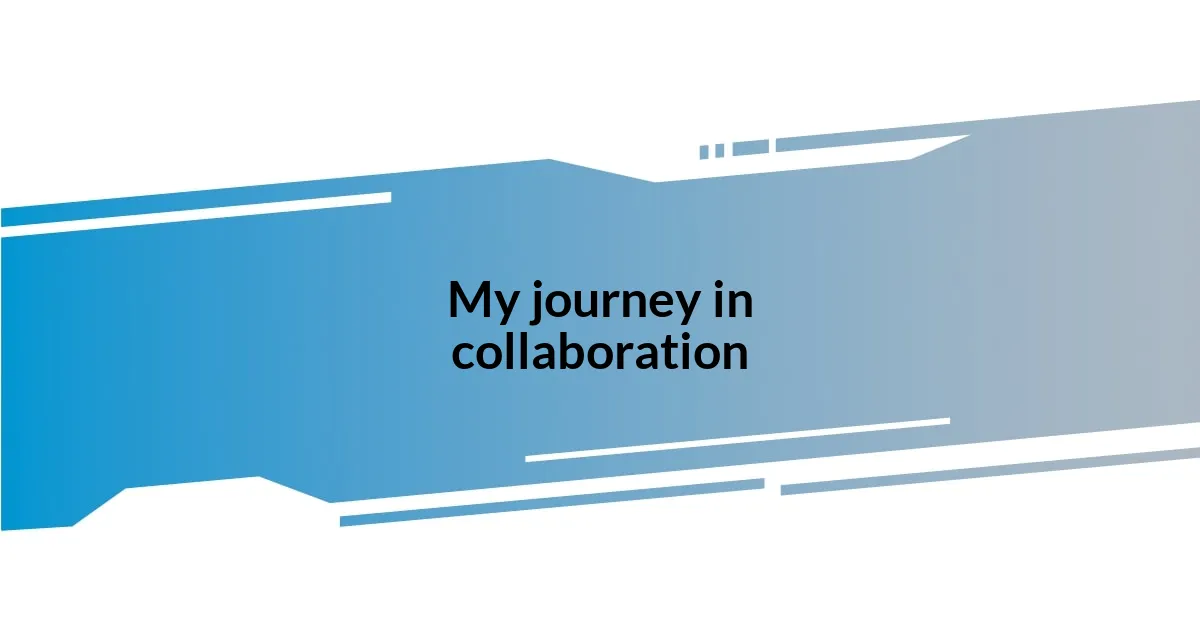
My journey in collaboration
Collaboration has been a transformative journey for me, shifting my perspective on creativity. I remember the first time I teamed up with a mural artist; I was nervous about sharing my ideas. But as we painted side by side, I felt a rush of excitement seeing our styles blend and create something entirely new.
One of the most memorable experiences was working on a multidisciplinary project where musicians, dancers, and visual artists came together. I was struck by the energy in the room – each contribution sparked inspiration in the others. It made me wonder: how can we harness these diverse talents to foster even deeper connections in our work?
Through these collaborations, I’ve learned the importance of vulnerability and trust. It can be intimidating to share raw ideas, but the magic truly happens when we let our guards down. Embracing this has taught me that collaboration is not just about creating art; it’s about building relationships and enriching our own creative paths.
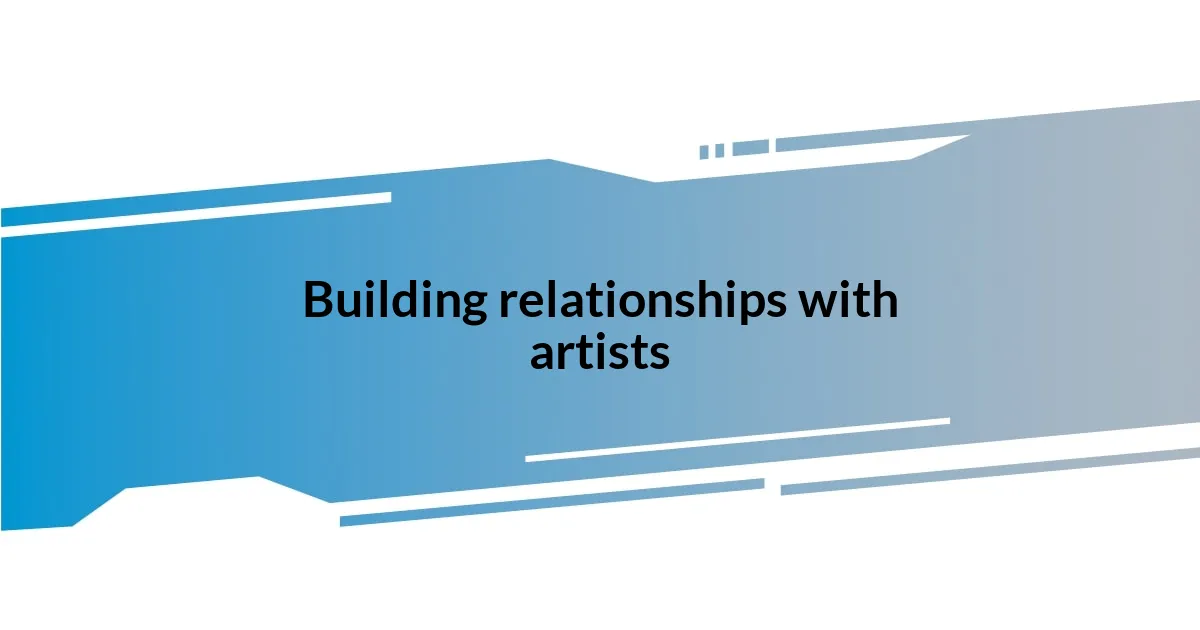
Building relationships with artists
Building relationships with artists is an intricate dance of shared visions and mutual respect. I recall a time when I reached out to a local photographer whom I admired. Initially, I felt apprehensive about expressing my ideas, fearing they might not resonate. But once I took the leap, our conversations flowed effortlessly, leading to collaborative pieces where her visual narratives complemented my text beautifully. Each meeting left me energized, and I realized how essential open communication is in nurturing these artistic bonds.
- Initiate Communication: Start by simply sharing your work and expressing admiration for theirs.
- Show Genuine Interest: Ask about their processes, inspirations, and struggles to create a deeper understanding.
- Share Experiences: Opening up about your own journey can foster trust and connection.
- Attend Events Together: Participate in art shows or workshops to bond over shared experiences.
- Offer Constructive Feedback: Respectfully discuss ideas, making it clear you value their perspective.
Through these steps, I found a sense of community that enriched my creative practice immensely.
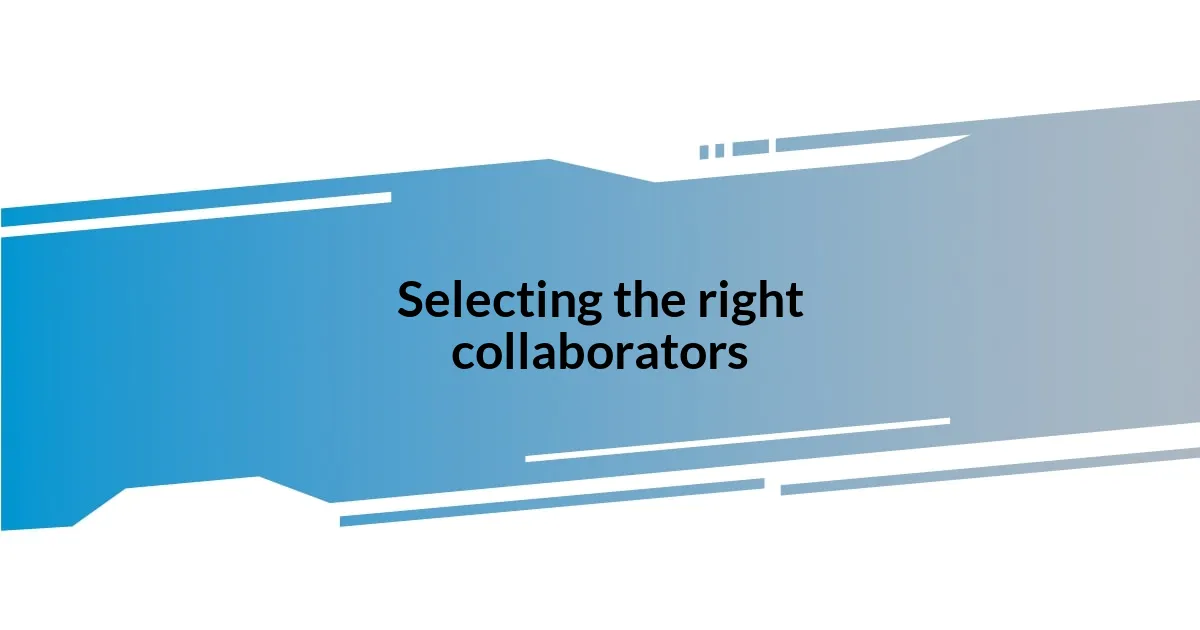
Selecting the right collaborators
Selecting the right collaborators can profoundly impact the quality of the artwork and the overall experience. One of my most rewarding collaborations came when I teamed up with a graphic designer. I chose her because I admired her keen eye for detail and her ability to convey emotions through colors and shapes. As we worked together, I realized that aligning our creative visions was essential. It reminded me that compatibility in artistic styles isn’t just about aesthetics; it’s about shared values and goals.
While it might be tempting to collaborate with someone simply because of their popularity or technical prowess, I’ve found that genuine connection means more. For instance, I once approached a musician who was well-known but didn’t resonate with my artistic ethos. We quickly discovered that our creative instincts clashed, and the collaboration became more of a struggle than a synergistic experience. Consequently, I learned that it’s better to select collaborators who align with your artistic vision, even if they are not widely recognized.
Evaluating potential collaborators shouldn’t just involve assessing their skills, but really understanding their creative process and passion. Asking questions about their inspirations and previous projects can reveal if they’re a good fit. When I collaborated with an up-and-coming sculptor, we spent hours discussing our journeys and influences. The resulting artwork was a true reflection of both our spirits, which was incredibly fulfilling.
| Criteria | Example |
|---|---|
| Artistic Compatibility | Aligns in vision, style, and purpose |
| Shared Values | Mutual respect and understanding of each other’s processes |
| Communication Style | Openness to feedback and discussion |
| Emotional Connection | Stronger bonds enhance creative flow |
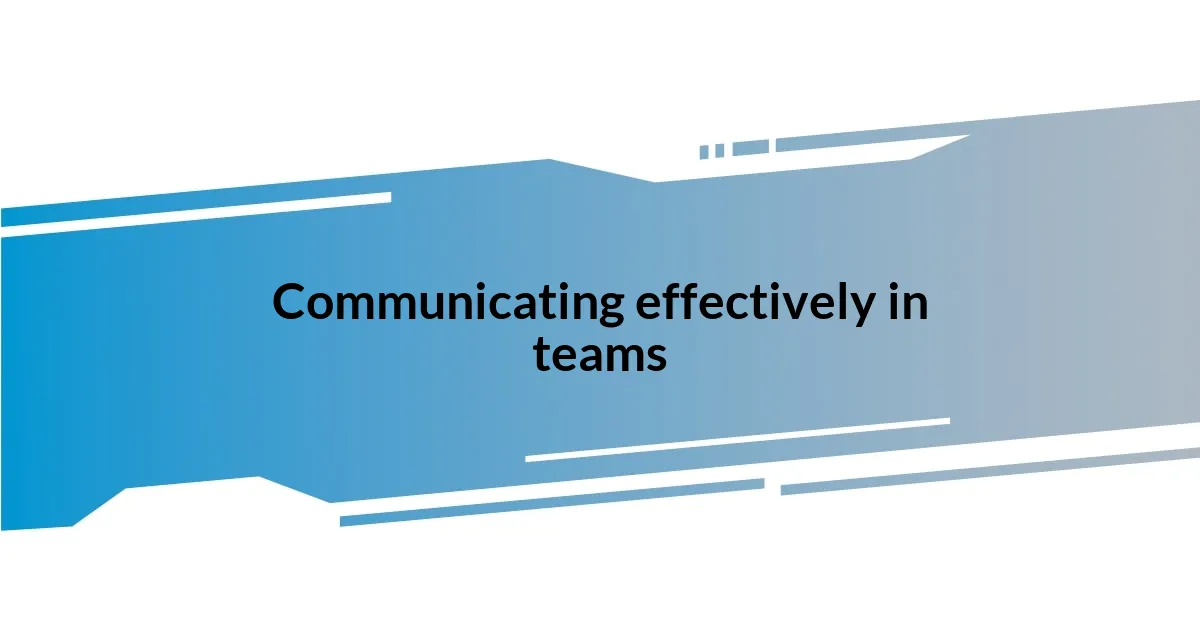
Communicating effectively in teams
Effective communication within a team of artists is essential for successful collaboration. I remember working on a mural with a diverse group, where we all had different artistic styles. Initially, I was concerned about how our ideas could mesh. However, when we set aside time for open dialogue, allowing everyone to express their thoughts without judgment, I was amazed by the magic that unfolded. It felt almost like a brainstorming session where each suggestion built upon the last, creating a synergy I had never anticipated.
One key aspect of communication is actively listening. I’ve found that when teammates genuinely listen to one another, it transforms the dynamic. During a project, I noticed that the quieter members often had brilliant insights but hesitated to speak up. By encouraging everyone to share their ideas in a supportive environment, we fostered a sense of belonging. It was incredible how just a little encouragement led to the unearthing of fresh concepts that elevated our work.
That said, it’s also important to clarify expectations from the start. In one project, I assumed we were all on the same page about our roles, but misunderstandings led to frustration. I learned quickly that outlining responsibilities early on creates a framework for accountability. This not only alleviates stress but also strengthens trust within the group. So, how do you clarify your roles? A simple brainstorming document where each person lists their responsibilities can work wonders in ensuring everyone is aligned.
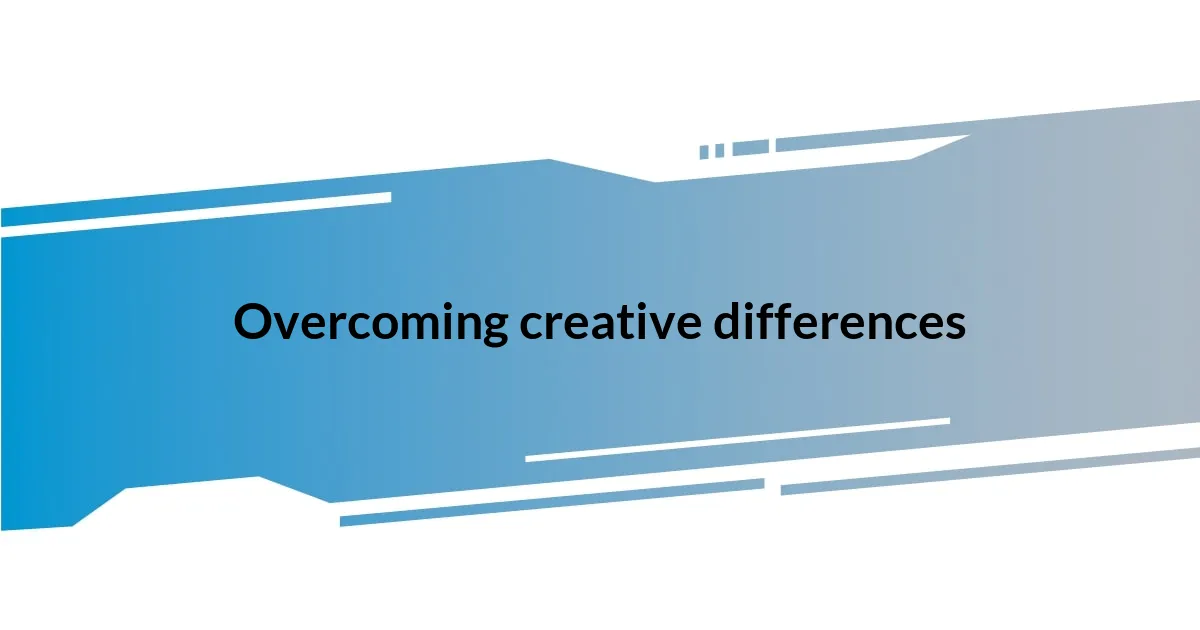
Overcoming creative differences
Collaboration can be a dance between creativity and conflict, especially when artists have different visions. I recall a project where my style clashed with a painter’s detail-oriented approach. Instead of letting it spiral into frustration, we held a candid discussion to express our views. It was refreshing to hear her perspective, and by exploring the roots of our differences, we found common ground that actually enriched the final piece.
In another experience, I worked with a group on an exhibition, and our ideas were all over the place. It felt like we were driving in separate directions. I remember one late-night session where we grabbed coffee and just shared our inspirations. It turned out that some of us had similar influences we hadn’t even realized. This exercise not only broke down barriers but also ignited a collaborative spark that led to unexpected and delightful outcomes.
I’ve often wondered why creative differences can be so daunting. But I’ve come to see them as opportunities for growth. Sometimes, it feels like a fight, and other times, a discovery. I learned that embracing those differences rather than avoiding them can lead to powerful, unexpected art. After all, isn’t that what collaboration is about—creating something that embodies the voices of all involved?
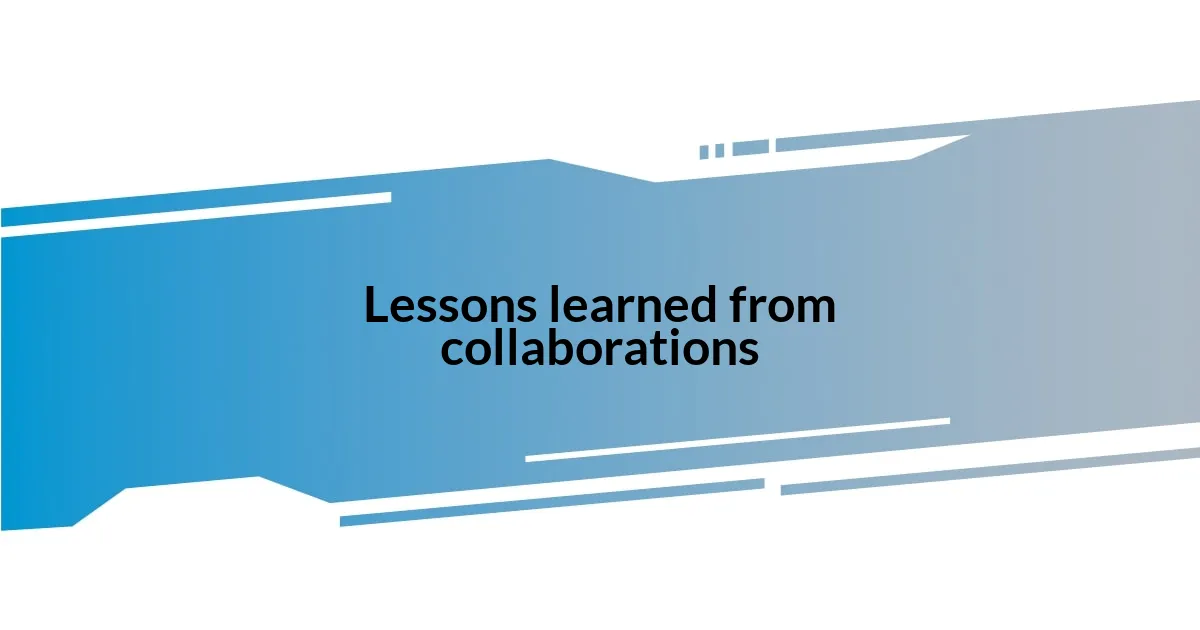
Lessons learned from collaborations
One major lesson I’ve learned from collaborating with fellow artists is the importance of flexibility. In one instance, while working on a joint installation, I had envisioned the piece turning out a certain way. However, as my partner’s unique ideas began to unfold, I found myself letting go of my original plan. The end result became a beautiful tapestry of both our styles, which I never would have created alone. So, how does one embrace this flexibility? It starts with trusting your partner and staying open to new ideas.
Another key takeaway has been the power of compromise. I recall participating in a mixed-media project where we struggled to agree on color choices. After a somewhat heated discussion, we decided to create a small test piece incorporating elements from both of our palettes. This exercise not only resolved our differences but also taught me that compromise can lead to surprising new directions, further enhancing our creative capabilities. Sometimes, the smallest adjustments can breathe new life into a project.
Additionally, I’ve realized that the post-project reflection can be invaluable. After completing a collaborative mural, we gathered for a casual debrief over coffee. Sharing what went well and where we felt challenged created a feedback loop of growth. It highlighted areas for improvement for future projects and strengthened our bonds as artists. Reflecting together not only fosters community but also enriches our practice, don’t you think? This kind of open dialogue post-collaboration is something I now prioritize, as it promotes continuous improvement and connection.
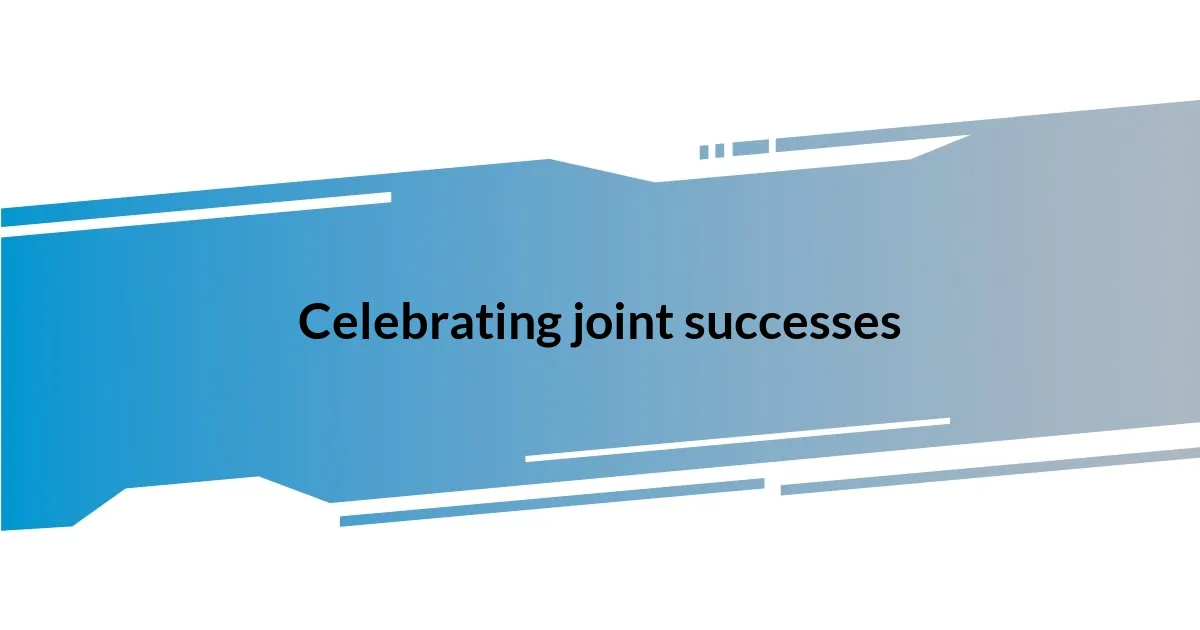
Celebrating joint successes
There’s something incredibly fulfilling about celebrating joint successes with fellow artists. I remember the exhilaration I felt after completing a collaborative mural with a team of talented creators. Once we stepped back to admire our work, the sense of pride was palpable—not just in my individual contribution, but in what we achieved together. At that moment, the colors, shapes, and shared visions merged into something greater than the sum of our parts.
One time, after wrapping up a performance art piece, we held a small gathering to toast our achievement. As we shared stories about our creative process, laughter filled the room, punctuated by discussions on how we could have done things differently. Reflecting on that moment, it struck me how vital it is to not only recognize our collective victory but to embrace the journey we took. Isn’t it fascinating how our individual strengths came together to create a single harmonious experience? That’s what makes collaboration such a powerful endeavor.
I also cherish the moments when we received positive feedback from our community. The first time we displayed a joint project at a local gallery, the excitement was infectious. As people interacted with our work and shared their insights, I felt a surge of gratitude for my fellow artists. Their perspectives enriched our creation, turning it into a conversation rather than a monologue. Have you ever experienced that rush of validation when a joint effort resonates with others? That shared success not only fuels my passion for collaboration but also reinforces the notion that together, we can create a profound impact.